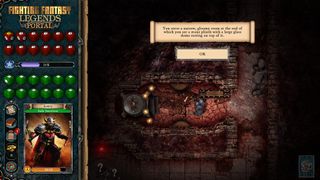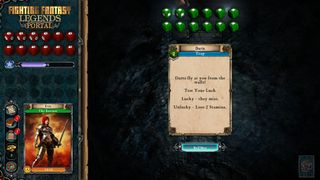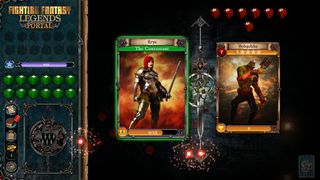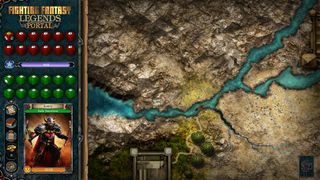
Thirty-five years ago, Penguin published The Warlock of Firetop Mountain, the first in the enormously popular Fighting Fantasy series of gamebooks. Penned by Games Workshop founders Steve Jackson and Ian Livingstone, Fighting Fantasy established the choose-your-own adventure genre, introducing readers and roleplayers alike to a whole new way of being hoisted upon their own petards.
Last year, Nomad games launched Fighting Fantasy Legends, a top-down, point-and-click PC adaptation of the first three Fighting Fantasy Books, created with the input of Livingstone and Jackson. Now, the cumbersomely named Fighting Fantasy Legends Portal brings together three more Fighting Fantasy adventures, centred around arguably the most famous gamebook ever written—Deathtrap Dungeon.
Alongside Deathtrap, the other two adventures are Trial of Champions, which is basically Deathtrap Dungeon nightmare-mode, and Armies of Death, which concludes the Deathtrap trilogy with a very different adventure. Unlike Legends, which weaved all three of its adventures together into a single game, Portal’s adventures are separate and played through in sequence, commencing with Baron Sukumvit’s challenge to best his infamous Labyrinth of Fang.

Each adventure begins with you creating a character from a trio of archetypes, namely Rogue, Paladin and Chaos Warrior, and imbuing them with a special trait, such as being immune to curses. You can also adjust how many skill and luck dice your character can roll in combat and ability checks (which are added at the cost of a lower overall health) and adjust the overall difficulty by selecting how many lives you’ll have for the adventure (3, 6, or 9).
Story-wise, Portal’s adaptations are relatively faithful to the book. In Deathtrap, you brave the Dungeon alongside five other adventurers, all competing to be the first out the other side. Your objective is to face down two trials and collect several gemstones in order to safely exit the dungeon. Many of the core encounters are found in the same locations as the book, such as the Riddlemaster and the Barbarian Throm.
More important than these specifics however, is that Nomad embraces the spirit of the book, namely its speedy pace and litany of fearsome challenges. In your adventures, you’ll walk across burning lava-pools, navigate deceptive illusions that conceal deadly traps, choose whether to heed or ignore the advice of potentially treacherous spirits, and battle with monsters that include the Manticore and the fearsome Bloodbeast.

At the same time, Nomad uses the dynamism videogames offer to its advantage in multiple ways. Some encounters offer more choice than before, such as the Riddlemaster, who will challenge you with different conundrums each time you meet. Interspersed within the fixed challenges are randomised encounters. The game pulls a card from the top of a deck set in the lower-right corner of the screen. These could be useful items, such as potions that restore Stamina (health) or charms that help you avoid skill or luck checks. More commonly, however, deck will reveal a trap you’ll need to pass a luck-check to avoid or spawn a monster that wants to use your skull as a drinking vessel.
The biggest gaming news, reviews and hardware deals
Keep up to date with the most important stories and the best deals, as picked by the PC Gamer team.
Combat is settled in the time-honoured tradition of rolling dice until someone dies. Each combatant has a maximum of twelve dice (though most monsters have between four and eight), and each die has one marked face on it. If that face lands upward, that represents a hit. It’s basic stuff, but well presented. I particularly like the way successful die will fly across the screen and strike the opponent’s card, as if they’ve been hurled from a sling.

As with any other RPG, you gain experience each time you emerge victorious from combat or succeed in a skill or luck check. When you level up, you get to add a face to one or your die, increasing the chances of a successful roll (up to a maximum of three marked faces per die). It’s up to you whether you upgrade your skill or luck die, depending on which you feel is more important in getting through the Dungeon unscathed. Should you lose a life, you’ll be catapulted back to the start of the dungeon, albeit with all your experience and equipment intact.
For the most part, Portal is a smart adaptation of Deathtrap and its sequels. But there are a few areas where the transition doesn’t work so well. In Deathtrap, if you reach the end of the dungeon without having found all the gems, then you’re sent right back to the start. And since you can only choose one route through the dungeon at any given time, this makes locating the last couple of gems an infuriating process, as you have to face down a whole bunch of random encounters again just to try a new path.

More broadly, it’s a shame that Portal isn’t woven neatly together in the way that Legends was, although I can see why doing so would have been difficult. Legend’s locations were evenly spread out and could be played in any order, while two of Portal’s adventures occur in the same place, and the third happens chronologically much later than the first two.
In addition, while Deathtrap focuses purely on the dungeon, Trial of Champions includes a lengthier prologue which offers the opportunity to solve a murder before returning to the Baron’s new, even deadlier labyrinth. Nonetheless, there are ways that some continuity could have been baked in, such as letting you carry over the same character, rather than being forced to create a new one for each adventure.
All told, though, this is a perfectly enjoyable interpretation of the Deathtrap gamebooks into a virtual format. It may not be quite as ambitious or as clever as Legends in terms of how it approaches that adaptation, but it nonetheless succeeds in finding a new and entertaining way to spin these decades-old adventures.
Fighting Fantasy Legends Portal is now on Steam.
Most Popular

